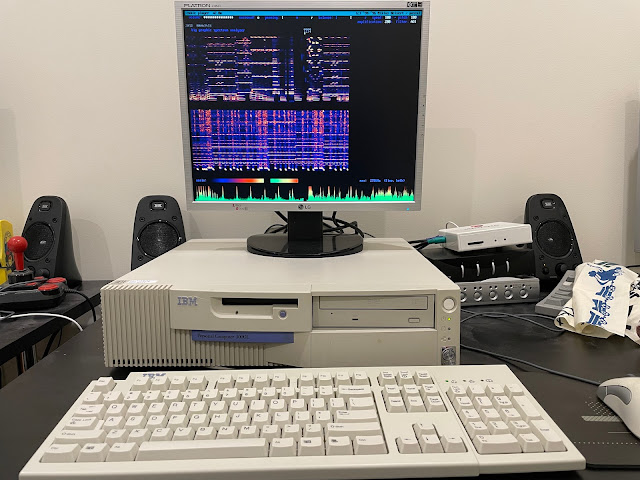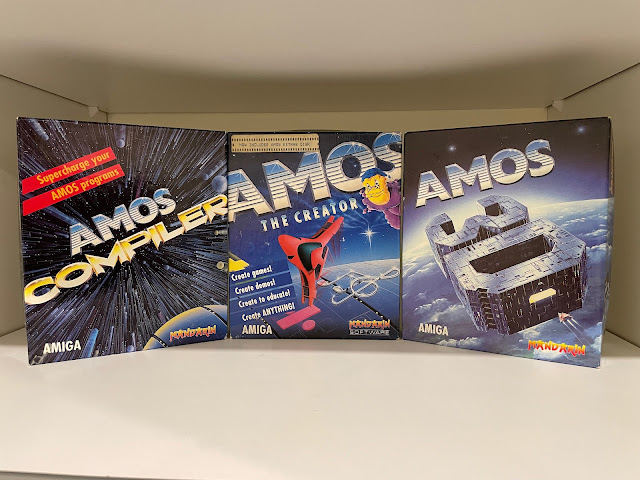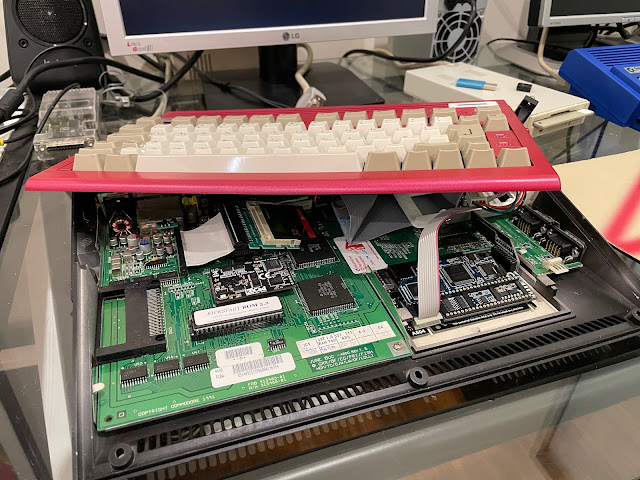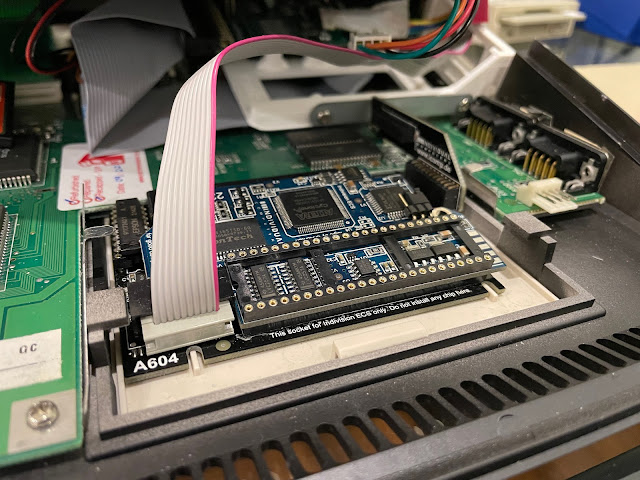It was announced that the Adelaide Retro Computing Group meeting in December would be a DOS themed meeting called Doscember. A few years ago I setup a Pentium 200MMX as my ultimate MS-DOS machine for running demos on the PC from the peak period for this in the 1990's.
I decided to delve a little deeper and find out what else I could do with the setup to show at the meeting. I was surprised at what else you can run under MS-DOS!

I know that I spend a lot of my focus on Amiga systems, but there was a period in the mid 1990's (from 1994-1996) that I didn't have access to any Amiga systems and I was using a PC running MS-DOS, Windows for Workgroups 3.11 and Slackware Linux.
I used it to do my Uni assignments, do ADA, Assembly, COBOL, C, Prolog and other programming for my Uni courses, and of course learn how to build and setup multiple operating systems. Oh, and demos and games of course!
I also did some mucking around with IBM OS/2 Warp at that time too as a friend of mine was a mad OS/2 fan and showed me the ropes to get it working on my PC.
Fast forward to 2016, and I decided to buy a Pentium 200MMX PC. Specifically an IBM 300GL PC to run MS-DOS 6.22 with my favourite DOS demos and games from that period! 64MB memory, Soundblaster 16, Tseng Labs ET6000 graphics card and a 8GB hard disk.
I know I could run FreeDOS for a more modern DOS experience, but I wanted it as I remembered it.
Amazingly although I long ago sold off my old DOS computers, I did keep the original software! So that came in handy to get MS-DOS installed and some games on it!
I set up two 2GB partitions for MS-DOS.
Some things you never forget. The bane of most MS-DOS PC owners life was trying to optimise the 640k conventional memory (that Bill Gates said was all we ever needed) to maximise the free memory to be able to run demos and games successfully.
I remember playing endlessly with memmaker before giving up on it and learning how to optimise memory use myself. Ultimately I am happy with the conventional memory situation on the Pentium 200MMX...
I have mouse driver, CDROM driver, sound card, and many other drivers loaded into High memory to maximise conventional memory. I use ANSI.SYS as I like having a customised DOS prompt. :-)
I use multiple configurations in the auto exec.bat to enable me to have the maximum conventional memory for really picky demos and games without a cd or mouse.
I also have configuration for starting networking on boot up, using the still updated MTCP package. As you can see, my config.sys and auto exec.bat are busy!
I have a 3Com Etherlink 100 PCI network card in my PC, so after I downloaded the packet driver for it, I could then setup MTCP to use it. MTCP comes with fantastic instructions on how to set it up - so much easier than using Microsoft's DOS networking package.
I then wrapped the MTCP initialisation commands into a "net.bat" script I placed in the path so I can start the network when I need it, rather than it using up precious conventional memory when I don't.
With networking working on the Pentium 200MMX, I could then open it up to try out internet programs under MS-DOS. I confirmed internet was working by pinging google.com:
Next, I did MS-DOS telnetting to BBS's hosted on the internet!
I used the Amiga Brisbane Retro Group BBS to try it out - and it works great - ANSI all supported and looking great:
I even chatted to the BBS Sysop while I was online on the BBS:
I even squeezed in a BBS Door game or two - two player Chess anyone?
Next I got more ambitious and setup Web browsing via a graphical DOS web browser called Arachne.
Having DOS USB support setup on my PC makes transferring files a lot less painful, although you do need to use small capacity USB drives to have them readable under MS-DOS. Mine is 512MB and works well.
I got to work installing Arachne Web browser on MS-DOS:
Having a VESA 2.0 compliant video card (Tseng Labs ET6000) for demo use is also useful when using the Arachne web browser, as it opens up higher resolution higher colour screen modes to use when web browsing under MS-DOS.
I selected 1024x768 2MB HiColor, as my video card is 2MB and that is the limit. The browser initial setup is very intuitive and easy to setup.
It makes the changes needed to the auto exec.bat and creates a a.bat shortcut to run the browser at any time from MS-DOS (with the networking run first of course):
You have a few options for setup, but since I have a packet driver installed for MTCP, this part was straight forward.
Setup is now all done.
I didn't bother with email setup, but it is pretty cool that this is possible under DOS too! Arachne has a lot of cool functionality which I need to explore further later on!
For now though, I browsed to aminet.net first, and it works great, with a few images missing:
As you would expect, DOS application web browsing is quite limited by the support of SSL certificates and many modern web browsing functions that simply are not supported in DOS. You can though use some useful online web sites like theoldnet.com that translate complex sites into something a more simple web browser like Arachne can process:
Next thing I played with was playing MP3 files in DOS. Yes, you can do this! Using a program called MPXPlay, I could playback MP3 files in DOS - it plays module files too:
Here are some MP3's playing under DOS. I did have to shorten the file names to 8.3 format first of course, which is a bit tedious.
On MS-DOS I generally use Cubic Player for module playback, and it is still an awesome program for doing that.
It has lots of different views, showing the live patterns, instruments, equalisers, and more.
This mode does some funky realtime stuff to show the patterns of the audio output - to me it just looks cool.
These days, Cubic Player has been moved to Open Cubic Player, available on multiple formats. I use it on my modern linux PC also for the same purpose as on the original MS-DOS PC that it was derived from!
I also learnt how to load a CD Player TSR (Terminate Stay Resident) programs that allows me to play and control an Audio CD from MS-DOS while doing other things in DOS!
To do this, it uses a one line strip of information, which you can choose where to locate on the screen:
Here is a close up of it - you can control whether the strip is visible or not (the CD keeps playing even when it isn't), and bring it up with a hotkey to control the CD again - Play/Stop/Next/Previous):
Very neat, and it shows the track number, play time and remaining time too!
Next thing I had to try out was Adobe Acrobat Reader for DOS!
I had no idea Acrobat Reader was originally released for MS-DOS!
I downloaded the original floppy disk images, wrote them out from the linux PC to a USB connected floppy drive so I could install them on my MS-DOS PC.
Adobe Reader for MS-DOS has an impressive GUI:
And yes, it displays PDF files under MS-DOS!
I then found out that the famous After Dark screensaver from MacOS was actually ported over to MS-DOS as well!
The things you find out! Completely useless in my opinion, but kinda fun to play around with - it has sound too, and kicks in after a few minutes of inactivity:
Back in the day, when I had my old MS-DOS machine, I used to run Windows for Workgroups on it and ran MS Office 4.3 on it for my assignments.
The MS-DOS version of Microsoft Word was very basic, and Excel didn't exist at all (they had an earlier product called Multiplan for DOS). In the DOS era, Word Perfect was king.
I tracked down the ten (!) disk installer for Word Perfect 6.2, and wrote out the floppy images again to install it on my MS-DOS PC:
I never used this program under DOS, so I was curious about it:
The installation is long and complex, and takes a while to complete.
Eventually though, I got it installed:
This version of Word Perfect can run in the traditional text only mode, or this rather fancy WYSIWYG GUI version - you can customise to add lots of buttons to the interface too:
Here is the boring text mode - who wants to use this...
Moving on, I also got MIDI files playing back nicely on my MSDOS machine thanks to MegaMID player:
I even got video playback working on MS-DOS! Unfortunately no pictures of this, and it is limited to some low res videos only, as I don't have a video card that offers hardware acceleration for playback. But it is possible under DOS!
With the DOS machine nicely setup, I took it to the Doscember meet at the Adelaide Retro Computing Group a week ago.
Quite a few people where as surprised as I was that you can open PDF files in DOS.
There were a lot of interesting DOS systems on display:
I am first and foremost an Amiga fan, but being a DOS themed event I didn't expect to see anything related to it. I was surprised to see some Commodore DOS PC's at the meet:
Seems I wasn't the only one playing MP3's on their DOS box today!
Classic DOS games like Doom, Quake and Duke Nukem 3D were running everywhere, even on iMac G3's!
Interesting machine I saw at the meet was this HP touch screen model! I had never seen one of these before!
There was one Amiga at the meet, much to my surprise. It needed fixing though.
I enjoyed running some of my large MS-DOS demo collection on the night.
Some people were interested in seeing OS/2 Warp 4 on my PC, so I briefly brought it up so people could see what it looked like, as many people have never used it!
I had a great time at Doscember, and the number of cool MS-DOS PC's at the meeting was impressive.
Most of all though, I enjoyed finding out about new software and functionality I didn't know MS-DOS could even do, and to get it working on my own machine was very satisfying!
Hopefully it inspires some of you to do your own MS-DOS PC projects!


































































































